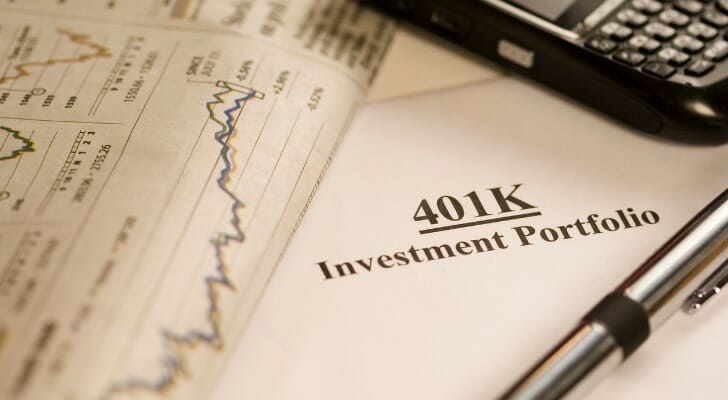Despite what was seen in the 2010s, the stock market cannot go up forever. Corrections typically occur every few years when stocks decline 10% or more from their most recent peak, sometimes lasting several months at a time. Stock market crashes, on the other hand, are less common than corrections but are more abrupt and severe. For proof, one has to look no further than the 2008 financial crisis or the 2020 crash during the COVID-19 pandemic. Thankfully, preparing for market volatility ahead of time is possible.
A financial advisor can help you make moves to protect your retirement savings from market volatility.
Protecting Your 401(k) From a Stock Market Crash
Any time you invest in the stock market or other assets, you face the possibility of losses. Even well-researched decisions can turn out differently than expected, and the importance of retirement savings can make it harder to separate emotions from investment choices.
There are, however, practical ways to manage risk. Diversifying your holdings across different asset types can help steady your portfolio and reduce the impact of sharp swings in any single investment. This approach spreads exposure and can make your overall strategy more resilient.
Over long periods, market downturns are difficult to avoid, but their effects can be softened. Staying invested and giving your portfolio time to participate in a recovery may help limit long-term damage and support more stable progress toward your retirement goals.
To begin building your retirement savings, these are some of the most influential strategies that can help minimize losses in your portfolio, even in the event of a stock market crash. Just remember that you can never completely eliminate risk, no matter what strategy you use.
Don’t Panic and Withdraw Your Money Too Early
Surrendering to the fear and panic that a market crash elicits can cost you. Withdrawing money early from a 401(k) can result in hefty IRS tax penalties and a hit to your future nest egg. It’s especially important for younger workers to ride out the market lows and reap the rewards of the future recovery.
Even people nearing retirement age may rebound from a crash in time for their first withdrawal. Consider the pandemic-fueled crash of 2020 as a case study. The Dow Jones Industrial Average, which notched an all-time high of 29,551.42 on Feb. 12, 2020, fell to just above 19,000 by March 20, 2020. Then on April 15, 2021, it posted an intraday high of more than 34,000.
Spooked investors who pulled their money from the market in March 2020 missed out on the bull market that pushed the DJIA to record highs by November 2020 – just eight months later. The Dow reached an all-time high of 36,585 on Jan. 3, 2022, and continued to climb in the following years, crossing the 40,000 mark in May 2024.
Diversify Your Portfolio

Finding the right asset allocation can be key for protecting your 401(k) from a stock market crash, while also maximizing returns. As an investor, you understand that stocks are inherently risky, and as a result, offer higher rewards than other assets. Bonds, on the other hand, are safer investments but usually produce lesser returns.
Building a Diversified 401(k)
Having a diversified 401(k) of mutual funds or exchange-traded funds (ETFs) that invest in stocks, bonds and even cash can help protect your retirement savings in the event of an economic downturn. How much you choose to allocate to different investments depends in part on how close you are to retirement. The further you are from retiring, the more time you have to recover from market downturns and full-fledged crashes.
Therefore, workers in their 20s would likely want a portfolio more heavily weighted in stocks since they have more time to weather a downturn before retiring. Their coworkers who are nearing retirement age, on the other hand, would probably have a more even distribution between lower-risk stocks and bonds to limit exposure to a market drop.
Using the Age-Based Rule of 110
But how much of your portfolio should be invested in stocks vs. bonds? A general rule of thumb is to subtract your age from 110. The result is the percentage of your retirement portfolio that should be invested in stocks. More risk-tolerant investors can subtract their age from 120, while those who are more risk-averse can do the same from 100.
However, the above rule of thumb is fairly basic and limiting, as it doesn’t allow you to account for any of the specifics of your personal situation. A more comprehensive approach would be to build an asset allocation based on your goals, risk tolerance, time horizon and more. While you can technically create your own portfolio allocation plan, financial advisors typically specialize in it.
Rebalance Your Portfolio
Rebalancing your portfolio, or changing how much you have in different assets, is another vital component of protecting retirement savings from crashes. The idea is that over time, some investments may fare better than others, changing the percentage of money in each asset and potentially exposing you to more risk. By rebalancing, you bring the percentage of money invested in stocks and bonds back in line with your original investing target from the section above.
The easiest way to ensure your 401(k) is continually rebalanced is to invest in a target-date fund, a collection of investments designed to mature at a target date. Target-date funds automatically rebalance their investments, moving to safer assets as the target date approaches.
But if you pick your own 401(k) investments, you’ll want to rebalance your portfolio at least once a year. Some financial advisors may recommend rebalancing as often as once a quarter. You can do this by selling off positions with gains that have tipped your portfolio out of balance. This is especially important for investors who are nearing retirement. It’s also worth noting that rebalancing isn’t the same as withdrawing money. These transactions take place within your 401(k) and won’t immediately result in taxes.
Keep Making Contributions to 401(k) and Other Retirement Accounts
Steadily contributing to your 401(k) is another way to protect it from future market volatility. Cutting back on your contributions during a downturn may cost you the opportunity to invest in assets at discount prices. It’s also important to keep contributing during periods of strong growth, even when your investments are doing well. The temptation to scale back your contributions may creep in. However, staying the course can bolster your retirement savings and help you weather future volatility.
How to Respond to a Recession
Despite the perception that recessions and stock market slumps are always related, they are distinct and call for distinct responses from investors. Here are several guidelines for responding to a recession.
Seek Out Core Sector Stocks
During a recession, you might be inclined to give up on stocks, but experts say it’s best not to flee equities completely. Consider investing in the healthcare, utilities and consumer goods sectors. People are still going to spend money on medical care, household items, electricity and food, regardless of the state of the economy. As a result, these stocks tend to do well during busts (and may underperform during booms).
Focus on Reliable Dividend Stocks
Investing in dividend stocks can be a great way to generate passive income. When you’re comparing dividend stocks, some experts say it’s a good idea to look for companies with low debt-to-equity ratios and strong balance sheets. If you don’t know where to start, you may want to look into dividend aristocrats. These are companies that have increased their dividend payouts for at least 25 consecutive years.
Consider Real Estate
The 2008 housing market collapse was a nightmare for homeowners. However, it turned out to be a boon for some real estate investors. When a recession hits and home values drop, it may be a buying opportunity for investment properties. If you can rent out a property to a reliable tenant, you’ll have a steady stream of income while you ride out the recession. Once real estate values start to rise again, you can potentially sell at a profit.
Precious Metal Investments
Precious metals, like gold or silver, tend to perform well during market slowdowns. But since the demand for these kinds of commodities often increases during recessions or when recessions are expected, their prices usually go up, too. For example, when the Federal Reserve raised interest rates in March 2023, after the collapse of Silicon Valley Bank and Signature Bank, the price of gold and silver popped 1.54% and 2.79%, respectively.
Keep Some Cash on Hand
Some financial professionals recommend retirees have enough cash or cash equivalents to cover three to five years’ worth of living expenses. Having cash reserves can help pay for unexpected expenditures that a fixed income may not otherwise be able to cover.
Cash on hand can also mitigate what’s called sequence of returns risk. That’s the potential danger of withdrawing money early in retirement during market downturns. By selling low, you risk undermining your portfolio’s longevity.
However, with cash reserves, retirees can withdraw less money from their 401(k) during a market decline and instead use cash to cover living expenses. Some experts recommend having enough cash on hand to pay for up to a year of living expenses. Others recommend having twice as much.
Bucket Strategy for Retirement Income
The bucket strategy is a retirement income approach that divides your savings into three categories — or “buckets” — based on time horizon and risk.
The first bucket holds cash or short-term assets to cover immediate living expenses, typically one to three years. The second bucket contains moderate-risk investments like bonds, meant to replenish the first bucket over the medium term. The third bucket holds long-term, higher-growth assets such as stocks.
This setup allows retirees to avoid selling long-term investments during market downturns. Instead, they can draw from the cash bucket in the short term, while giving riskier assets time to recover. As the market rebounds, they can refill the cash and bond buckets using gains from the third bucket. This strategy helps balance growth and income needs. It also reduces the emotional pressure to sell during downturns.
How Age and Your Retirement Timeline Can Affect Your Portfolio
Your age and proximity to retirement play a critical role in how you prepare your 401(k) for a market crash. The longer your timeline, the more flexibility you have to ride out downturns. The closer you are to retirement, the more important it becomes to protect what you’ve saved.
For younger workers in their 20s and 30s, time is on your side. Market crashes can feel alarming, but you generally have decades to recover and continue contributing. Maintaining a stock-heavy allocation may make sense, since equities historically deliver higher long-term returns even with short-term losses. Regular contributions during downturns also allow you to buy assets at lower prices, potentially boosting future growth.
For mid-career investors in their 40s and 50s, risk management becomes more important. Retirement is approaching, and you may not have as much time to recover from deep losses. Gradually increasing your exposure to bonds and other lower-volatility investments can help reduce the impact of a market crash. At the same time, keeping some stock exposure is still valuable to support long-term growth.
For those nearing or already in retirement, portfolio protection takes priority. If you’re in your 60s or older, downturns can be especially damaging if you need to withdraw money while asset values are depressed. Holding cash reserves, relying on income-producing assets like bonds and dividend-producing stocks, and using strategies such as the bucket approach can help maintain stability. These tactics give your riskier investments more time to recover, reducing the pressure to sell during a downturn.
Bottom Line

Safeguarding your retirement savings from a market crash takes steady attention. Watching your asset allocation, keeping a mix of investments and rebalancing when needed can help keep your portfolio on track. Continuing to contribute to your 401(k) in both rising and falling markets can also support long-term growth, and staying calm during volatility can leave you better positioned for the recovery that follows.
Building on those principles, experts note that long-term investors will almost certainly experience downturns, but the right approach can still lead to strong outcomes.
“Virtually no investor can avoid a stock market crash, or even a downturn, if they’re invested over a period of decades. But they can still come out on top by diversifying across and within asset classes, contributing to retirement accounts consistently, and rebalancing their portfolio at least annually to align with their goals and time horizon. These strategies may not be flashy, but they’re time-tested,” said Tanza Loudenback, CFP®.
Tanza Loudenback, CFP® provided the quote used in this article. Please note that Loudenback is not a participant in SmartAsset AMP, is not an employee of SmartAsset and has been compensated. The opinion voiced in the quote is for general information only and not intended to provide specific advice or recommendations.
Tips for Protecting Your 401(k)
- Luckily, you don’t have to do all of this alone. A financial advisor can help you protect your retirement savings from future uncertainty. Finding a financial advisor doesn’t have to be hard. SmartAsset’s free tool matches you with vetted financial advisors who serve your area, and you can interview your advisor matches at no cost to decide which one is right for you. If you’re ready to find an advisor who can help you achieve your financial goals, get started now.
- When setting up your 401(k), take advantage of any employer match — failing to do so is leaving free money on the table!
Photo credit: ©iStock.com/D-Keine, ©iStock.com/martin-dm, ©iStock.com/Pears2295
